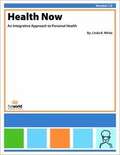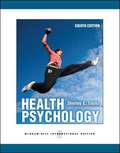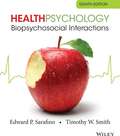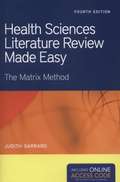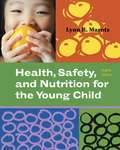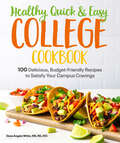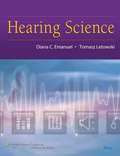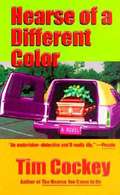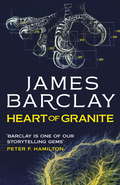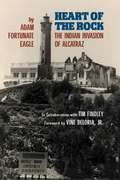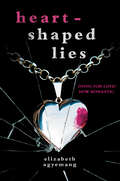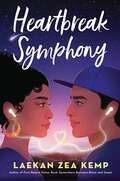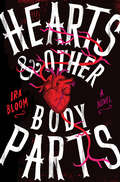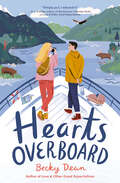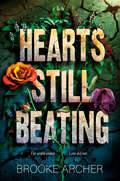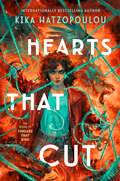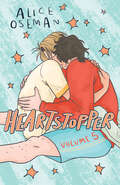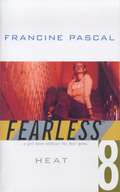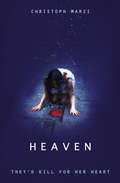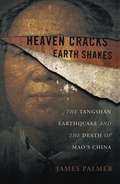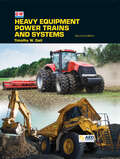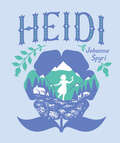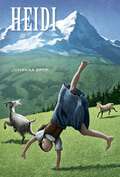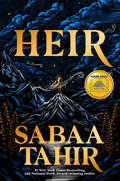- Table View
- List View
Health Now
by Linda B. WhiteIntended for the college-level Personal Health course. Health Now: An Integrative Approach to Personal Health by Linda B. White, M.D. covers the concepts you expect but adds a few important innovations that will capture students' attention and help you deliver the most current content. White pays far more than lip service to the rise of complementary and alternative medicine (CAM).
Health Psychology, Eighth Edition
by Shelley E. TaylorThe book highlights health issues that face the college student and his or her family through both accessible research examples and profiles of interventions such as coping with stress, maintaining physical health, and making decisions about alcohol and smoking. This edition contains clear descriptions of current research into the prevention, treatment, and causes (social, genetic, and biological) of specific health related disorders.
Health Psychology: Biopsychosocial Interactions (8th Edition)
by Edward P. Sarafino Timothy W. SmithSarafino draws from the research and theory of many disciplines in order to show psychologists how psychology and health affect each other.
Health Sciences Literature Review Made Easy: The Matrix Method (Fourth Edition )
by Judith GarrardHealth Sciences Literature Review Made Easy, Fourth Edition is an essential text for your nursing research course and provides students with a solid foundation and the tools they need to evaluate articles and research effectively. The Fourth Edition builds on the digital updates made to the previous edition and highlights the Matrix Method and the skills necessary to critically evaluate articles. The text also covers Method Maps, which teach students how to effectively construct a research study. The author leads students through the process of how to manage a quality literature review in the context of evidence-based practice. A case study highlighting a typical graduate student is woven throughout the text to illustrate the importance of literature reviews and evidence-based practice. Health Sciences Literature Review Made Easy, Fourth Edition is appropriate for graduate level nursing courses as well as undergraduate Nursing Research courses that require literature reviews. Key Features: • Data Visualization: A Digital Exploration is an interactive, online appendix • The Matrix Method teaches the essential skills around literature evaluation • A real-life scenario case study is woven throughout each chapter to reinforce key concepts • Completely updated chapter on the guidelines for Methodological Review • Method Maps are introduced to convey the thought process around designing a research study
Health, Safety, and Nutrition for the Young Child
by Lynn R. MarotzHEALTH, SAFETY, AND NUTRITION FOR THE YOUNG CHILD, 8th Edition, covers the contemporary health, safety, and nutrition needs of infant through school-age children in one comprehensive volume, with extensive coverage of topics critical to the early identification of children's health conditions and the promotion of children's well-being. Concepts are backed by the latest research findings and linked to the key professional standards of the field. Collaboration with families, sensitivity to individual differences, and the critical importance of health, safety, and nutrition education continue to be stressed. Written in a clear, concise, and thought-provoking manner, this time-proven book is filled with easy-to-access checklists, guidelines, and lesson plans that no early childhood student or professional should be without!
Healthy, Quick & Easy College Cookbook: 100 Simple, Budget-Friendly Recipes to Satisfy Your Campus Cravings
by Dana Angelo WhiteA cookbook for college students who want to eat well without breaking the bank, with 100 simple, nutritious, and delicious recipes.You don't need to survive on fast food for four years!Every busy college student knows how difficult it can be to eat healthy and also do it on a tight budget, but eating healthy doesn't need to be hard! Healthy, Quick & Easy College Cookbook has everything you need to make simple, delicious, nutritious recipes that you'll love, and you won't have to break your budget to do it. You'll learn how to make breakfasts that will fuel your day, lunches that are simple but satisfying, and main dishes that will impress anyone - including your parents. You'll also learn how to make healthier snacks that aren't loaded with salt and sugar, sweet treats that are better than anything from a bag, and late night treats that you actually won't regret eating the next day. Here's what you'll find inside:100 simple and healthy recipes that any student can make, with basic ingredients and simple instructions that even the most inexperienced cook can followHelpful guidance for stocking a campus kitchen with the right tools and the essential basic ingredientsSimple but helpful tips for successful cooking, getting the most out of ingredients, stretching a food budget, and storing food safely Meal prep basics that will help students take full advantage of the time they have and also help them stretch their ingredients
Hear My Voice/Escucha mi voz: The Testimonies of Children Detained at the Southern Border of the United States
by Warren BinfordThe Testimony of Children A moving picture book for older children and families that introduces a difficult topic, amplifying the voices and experiences of immigrant children detained at the border between Mexico and the US. The children's actual words (from publicly available court documents) are assembled to tell one heartbreaking story, in both English and Spanish (back to back). Each spread is illustrated in striking full-color by a different Latinx artist. A portion of sales will be donated to human rights organizations that work with children on the border.
Hearing Science
by Tomasz Letowski Diana C. EmanuelThis textbook provides a comprehensive presentation of all aspects of hearing science, including acoustics, psychoacoustics, anatomy and physiology, and related topics such as introduction to digital signal processing and instrumentation in hearing science. It is designed to supplement in-class instruction with both remedial and advanced material for students with different academic backgrounds, and is ideally suited for speech pathology and audiology students at the undergraduate and introductory graduate levels.
Hearse of a Different Color: A Hitchcock Sewell Mystery
by Tim CockeyHitchcock Sewell, Baltimore's hippest undertaker and civilian sleuth, is back in a second sly, original mystery.One of the most charming and offbeat amateur detectives to come around in years, Hitchcock Sewell does for the undertaking profession what Marilyn Monroe did for the ukulele--gives it a touch of class. In this rollicking follow-up to Tim Cockey's "witty, punchy, snappy, well-written, and dang funny debut" (Harlan Coben, author of The Final Detail), a surprise blizzard dumps more than snow on the steps of Sewell & Sons funeral home--it leaves behind the corpse of a murdered waitress as well. Hitch's television meteorologist girlfriend sees the crime as an opportunity to move into hard news. Her unctuous mentor wants to beat Hitch to the punch. Hitch's snooping takes him from low-life strip joints to high-tone mansions, proving yet again that undertakers and their clue-happy cohorts can be a pretty lively bunch.
Heart of Granite: Blood & Fire 1 (Blood & Fire #1)
by James BarclayThe world has become a battleground in a war which no side is winning. But for those determined to retain power, the prolonged stalemate cannot be tolerated so desperate measures must be taken.Max Halloran has no idea. He's living the brief and glorious life of a hunter-killer pilot. He's an ace in the air, on his way up through the ranks, in love, and with his family's every need provided for in thanks for his service, Max has everything . . .. . . right up until he hears something he shouldn't have, and refuses to let it go. Suddenly he's risking his life and the lives of all those he cares about for a secret which could expose corruption at the highest levels, and change the course of the war.One man, one brief conversation . . . a whole world of trouble . . .
Heart of the Rock: The Indian Invasion of Alcatraz
by Adam Fortunate Eagle Tim FindleyAn intimate memoir of the two-year invasion and occupation of Alcatraz by American Indians and of the events leading up to it. Traces and cultural agonies and federal pressures on American Indians "relocated" to urban areas that led to the invasion of Alcatraz.
Heart-Shaped Lies
by Elizabeth AgyemangJohn Tucker Must Die meets A Good Girl&’s Guide to Murder in this tongue-in-cheek mystery about three feuding exes of a social media prank star who are forced to work together to uncover the truth behind his death when his deactivated account resurfaces online with claims that one of them murdered him.Kiara, Priscilla, and Nevaeh have nothing in common—except they just found out that they&’re all dating Tommy Harding, the internet's most famous teen prank star. KIARA is the girlfriend who the cameras know and love, the academic star who Tommy parades around in public to keep his image in check. PRISCILLA is Tommy's co-star. As a beauty influencer and an accomplice to Tommy&’s notorious antics, she&’s always known that the two of them could be the Internet&’s power couple—if only he would confess to his girlfriend what really goes on during their 'rehearsals'.And NEVAEH is the good girl, the pastor's daughter who'd never dream of dating a boy who&’s already taken.When a viral post from Tommy&’s social media account exposes his cheating ways during their high school class trip to Florida&’s biggest theme park, the girls are crushed—and furious. Tommy claims his account was hacked. Now, Kiara, Priscilla, and Nevaeh want him out of their lives. Forever. After all, Tommy doesn&’t just hold their hearts—he holds their secrets, too.But when Tommy's body is found the next morning, their so-called wish becomes a twisted reality. Because Tommy may be gone, but the internet is forever. And the girls are about to go from strangers to suspects….
Heartbreak Symphony
by Laekan Zea KempClap When You Land meets On the Come Up in this heart-gripping story about navigating first love and overcoming grief through the power of music. Aarón Medrano has been haunted by the onstage persona of his favorite DJ ever since his mother passed away. He seems to know all of Aarón&’s deepest fears, like how his brain doesn&’t work the way it should and that&’s why his brother and father seem to be pushing him away. He thinks his ticket out is a scholarship to the prestigious Acadia School of Music. That is, if he can avoid blowing his audition.Mia Villanueva has a haunting of her own and it&’s the only family heirloom her parents left her: doubt. It&’s the reason she can&’t overcome her stage fright or believe that her music is worth making. Even though her trumpet teacher tells her she has a gift, she&’s not sure if she&’ll ever figure out how to use it or if she&’s even deserving of it in the first place. When Aarón and Mia cross paths, Aarón sees a chance to get close to the girl he&’s had a crush on for years and to finally feel connected to someone since losing his mother. Mia sees a chance to hold herself accountable by making them both face their fears, and hopefully make their dreams come true. But soon they&’ll realize there&’s something much scarier than getting up on stage—falling in love with a broken heart.
Hearts & Other Body Parts
by Ira BloomA novel of love and monsters.Sisters Esme, Katy, and Ronnie are smart, talented, and gorgeous, and better yet . . . all three are witches. They have high school wired until the arrival of two new students. The first is Norman, who is almost eight feet tall and appears to be constructed of bolts and mismatched body parts. Despite his intimidating looks, Esme finds herself strangely -- almost romantically -- drawn to both his oversized brain and oversized heart.The second new arrival is Zack, an impossibly handsome late transfer from the UK who has the girls at school instantly mesmerized. Soon even sensible Esme has forgotten Norman, and all three sisters are in a flat-out hex war to win Zack. But while the magic is flying, only Norman seems to notice that students who wander off alone with Zack end up with crushed bones and memory loss. Or worse, missing entirely. HEARTS & OTHER BODY PARTS is a wickedly addictive novel about love, monsters, and loyalty. And oh yeah, a Japanese corpse-eating demon cat.
Hearts Overboard
by Becky DeanSet sail with this banter-filled rivals-to-lovers romance between a STEM-loving girl and a jock guy that will fill you with wanderlust...and have you rooting for love in the great outdoors!Love is on the horizon...After a very public breakup during which her ex, Caleb, tells her she is both (a) boring and (b) stuck in her ways, Savannah Moore decides that going with her mom on her company cruise to Alaska presents the perfect opportunity to show people how fun she is.It won&’t be easy, though. Her longtime nemesis, Tanner Woods, is also on the ship. His family and Savannah's are friends, and Tanner knows her better than she&’d like to admit. When he learns of her plan, Tanner wants to help, and he encourages her to try everything: zip-lining and dogsledding, hiking the bear-infested Alaskan wilderness, singing late night karaoke, and taking a polar plunge. That&’ll show Caleb just what he&’s missing.Except after spending so much time with Tanner, Savannah&’s not sure Caleb is the one she wants anymore...
Hearts Still Beating
by Brooke ArcherGripping, romantic, and impossible to put down, this dark and immersive post-apocalyptic debut novel is about two teen girls who loved each other before the end of the world — and before one of them became infected with the virus that turned her into a monster. Perfect for fans of Krystal Sutherland, Adam Silvera, and the darkly human side of the HBO Max horror-drama The Last of Us.Seventeen-year-old Mara is dead—mostly. Infected with a virus that brought the dead back to life and the world to its knees, she wakes up in a facility to learn a treatment for the disease has been found. No longer a Tick, Mara is placed in an experimental resettlement program. But her recovery is complicated by her destination: she&’s sent to live with the best friend she hasn&’t seen since the world ended—and since their first and only kiss.Seventeen-year-old Rory is alive—barely. With impaired mobility from an injury and a dead sister, Rory&’s nightmares are just as monstrous as the Ticks that turned her former best friend. Even after the Island—one of a handful of surviving communities—rebuilds itself, Rory is prepared for the Ticks to return at any time. She never expected them to come in the form of the only girl she&’s ever loved.As the girls struggle with their pasts and the people they&’ve become, and with the Island&’s fragile peace in the balance, Rory and Mara must lean on each other to survive—or risk losing the girl they love all over again.
Hearts That Cut (Threads That Bind #2)
by Kika HatzopoulouIn this heart-pounding, much-anticipated sequel to Threads That Bind, Io will face threats even more dangerous and players even more powerful as she discovers what it will mean to follow—or defy—her fate.It&’s been five weeks since Io left Alante to follow the golden thread, and she&’s no closer to finding the god on the other end. She spends her days in constant, grueling travel and her nights worrying over the fate-thread she shares with Edei—which seems to be fraying. Making matters worse, she and Bianca soon realize that their only lead has shaken them off, snapped the golden thread, and disappeared.But not before Io gathers some crucial clues. Her investigation leads her to a new mystery, a rash of sibling disappearances across the Wastelands that seems to be connected to the murders in Alante. And all signs point to Nanzy, the golden city, as the center of the whole conspiracy.As Io and Bianca make their way to Nanzy, they face powerful enemies, find allies new and old, and uncover a horrifying plot that traces back centuries. The more Io learns, the more she begins to suspect that the future of the world may truly rest on her shoulders. But she will have to determine how much of the future is her choice—and how much is simply her fate.
Heartstopper #5: A Graphic Novel (Heartstopper)
by Alice Oseman*Now an acclaimed live-action Netflix series!*Boy meets boy. Boys become friends. Boys fall in love. The bestselling LGBTQ+ graphic novel about life, love, and everything that happens in between: this is the fifth volume of the much-loved HEARTSTOPPER series, featuring gorgeous two-color artwork.Nick and Charlie are in love. They’ve finally said those three little words, and Charlie has almost persuaded his mum to let him sleep over at Nick’s house. He wants to take their relationship to the next level... but can he find the confidence he needs? And with Nick going off to university next year, is everything about to change?By Alice Oseman, winner of the YA Book Prize, Heartstopper encompasses all the small moments of Nick and Charlie’s lives that together make up something larger, which speaks to all of us.Contains discussions around mental health and eating disorders, and sexual references.
Heat (Fearless #8)
by Francine PascalEveryone longs for something. And everyone gives in to temptation sometimes. Mary. Heather. Sam. Now it's my turn.
Heaven
by Christoph MarziThe night that Heaven lost her heart was cold and moonless. But the blade that sliced it out was warm with her dark blood...David Pettyfer is taking a shortcut over the dark rooftops of London's brooding houses, when he literally stumbles across Heaven: a strange, beautiful, distraught girl who says that bad men have stolen her heart. Yet she's still alive...And so begins David and Heaven's wild, exciting and mysterious adventure - to find Heaven's heart, and to discover the incredible truth about her origins. Part thriller, part love story and part fairy tale, this brilliantly orignal novel from a bestselling German author will take your breath away...
Heaven Cracks, Earth Shakes: The Tangshan Earthquake and the Death of Mao's China
by James PalmerWhen an earthquake of historic magnitude leveled the industrial city of Tangshan in the summer of 1976, killing more than a half-million people, China was already gripped by widespread social unrest. As Mao lay on his deathbed, the public mourned the death of popular premier Zhou Enlai. Anger toward the powerful Communist Party officials in the Gang of Four, which had tried to suppress grieving for Zhou, was already potent; when the government failed to respond swiftly to the Tangshan disaster, popular resistance to the Cultural Revolution reached a boiling point. In Heaven Cracks, Earth Shakes, acclaimed historian James Palmer tells the startling story of the most tumultuous year in modern Chinese history, when Mao perished, a city crumbled, and a new China was born.
Heavy Equipment Power Trains and Systems
by Timothy W. DellHeavy Equipment Power Trains and Systems covers the latest power train technology on the market, including later-model continuously variable transmissions. It provides extensive, balanced coverage of agricultural equipment and off-highway equipment from all sectors of the heavy equipment industry, including construction, mining, and forestry, and includes detailed technical information about equipment from a wide range of manufacturers. Heavily illustrated and featuring many detailed cut-away mechanical drawings developed by author Tim Dell, this text allows students to become familiar with equipment that may not be available in their labs. Case Studies throughout the text describe how the theory and procedures detailed in the chapter are applied to real-world diagnosis and service of specific types of heavy equipment.
Heidi (Children's Signature Clothbound Editions)
by Johanna SpyriThe beloved story of an orphaned girl living in the Swiss Alps is now available in an unabridged, illustrated cloth hardcover edition in Union Square and Co.&’s Children's Signature Clothbound Classics series. When Heidi&’s parents die and she can no longer live with her aunt, she must stay with her ill-tempered grandfather, who lives alone in the Swiss Alps. Heidi thrives in the mountains as she plays with the mountain goats, picks wildflowers, makes new friends, and brightens her grandfather&’s life. Then Heidi is taken away to serve as a companion to a lonely girl. Will she ever get back to the mountains and people she loves so much?
Heidi (Union Square Kids Unabridged Classics)
by Johanna SpyriWhat happens when a little orphan girl is forced to live with her cold and frightening grandfather? The heartwarming answer has engaged children for more than a century, both on the page and on the screen. Johanna Spyri’s beloved story offers youngsters an endearing and intelligent heroine, a cast of unique and memorable characters, and a fascinatingportrait of a small Alpine village.
Heir
by Sabaa TahirPrepare for a ruthless and romantic new fantasy from author Sabaa Tahir that introduces a new generation of characters set in the same world as the unforgettable An Ember in the Ashes series. <P><P> An orphan.<br> An outcast.<br> A prince.<br> And a killer who will bring an empire to its knees. <P><P> Growing up in the Kegari slums, AIZ has seen her share of suffering. An old tragedy fuels her need for vengeance, but it is love of her people that propels her. Until one hotheaded mistake lands her in an inescapable prison, where the embers of her wrath ignite. <P><P> Banished from her people for an unforgivable crime, SIRSHA is a down-on-her-luck tracker who uses magic to trace her marks. Destitute, she agrees to hunt down a killer who has murdered children across the Martial Empire. All she has to do is carry out the job and get paid. But when a chance encounter leads to an unexpected attraction, Sirsha learns her mission might cost her far more than she’s willing to give up. <P><P> QUIL is the crown prince of the Empire and nephew of a venerated empress, but he’s loath to take the throne when his aunt steps down. As the son of a reviled emperor, he, better than anyone, understands that power corrupts. When a vicious new enemy threatens the survival of the Empire, Quil must ask himself if he can rise above his tragic lineage and be the heir his people need. <P><P> Beloved storyteller Sabaa Tahir interweaves the lives of three young people as they grapple with power, treachery, love, and the devastating consequences of unchecked greed, on a journey that may cost them their lives—and their hearts. Literally. <p> <b>New York Times Bestseller</b>
